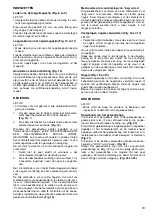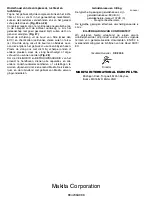
7
ENGLISH
Explanation of general view
1
Compressor air output per
minute
2
Nailing frequency (times/min.)
3
Pneumatic tool oil
4
Holder
5
Nose adapter
6
Magazine
7
Contact arm
8
Nose adapter
9
Adjuster
10
Pusher
11
Pusher lever
12
Depress
13
Return
14
Nail stopper
15
Air socket
16
Air fitting
17
Continuos nailing
18
Intermittent nailing
19
Change lever
20
Trigger lock
21
Hammer
22
Small rod
23
Ejection port
24
Driver
25
Pliers
26
Slot
27
Change lever
28
Trigger lock
29
Drain cock
30
Air filter
31
Oiler
32
Pneumatic oil
SPECIFICATIONS
Model
AN942
Air pressure .................. 0.44 – 0.83 Mpa (4.4 – 8.3 bar)
Nail Iength ..............................................50 mm – 90 mm
Nail capacity ................................................ 60 – 84 pcs.
Dimensions (L x H x W) .... 446 mm x 376 mm x 108 mm
Min. hose diameter .............................................. 8.5 mm
Net weight ..............................................................3.8 kg
• Due to our continuing program of research and devel-
opment, the specifications herein are subject to change
without notice.
• Note: Specifications may differ from country to country.
Power supply
The tool should be connected only to a power supply of
the same voltage as indicated on the nameplate, and can
only be operated on single-phase AC supply. They are
double-insulated in accordance with European Standard
and can, therefore, also be used from sockets without
earth wire.
Safety hints
For your own safety, please refer to the enclosed safety
instructions.
IMPORTANT SAFETY INSTRUCTIONS
ENB067-1
WARNING:
WHEN USING THIS TOOL, BASIC SAFETY
PRECAUTIONS SHOULD ALWAYS BE FOLLOWED TO
REDUCE THE RISK OF PERSONAL INJURY,
INCLUDING THE FOLLOWING:
READ ALL INSTRUCTIONS.
• For personal safety and proper operation and main-
tenance of the tool, read this instruction manual
before using the tool.
• Always wear safety glasses to protect your eyes
from dust or nail injury.
WARNING:
It is an employer’s responsibility to enforce the use of
safety eye protection equipment by the tool operators
and by other persons in the immediate working area.
• Wear hearing protection to protect your ears
against exhaust noise and head protection. Also
wear light but not loose clothing. Sleeves should
be buttoned or rolled up. No necktie should be
worn.
• Rushing the job or forcing the tool is dangerous.
Handle the tool carefully. Do not operate when
under the influence of alcohol, drugs or the like.
General Tool Handling Guidelines:
1.
Always assume that the tool contains fasteners.
2.
Do not point the tool toward yourself or anyone
whether it contains fasteners or not.
3.
Do not activate the tool unless the tool is placed
firmly against the workpiece.
4.
Respect the tool as a working implement.
5.
No horseplay.
6.
Do not hold or carry the tool with a finger on the
trigger.
7.
Do not load the tool with fasteners when any one
of the operating controls is activated.
8.
Do not operate the tool with any power source
other than that specified in the tool operating/
safety instructions.
• An improperly functioning tool must not be used.
• Sparks sometimes fly when the tool is used. Do not
use the tool near volatile, flammable materials such
as gasoline, thinner, paint, gas, adhesives, etc.;
they will ignite and explode, causing serious injury.
• The area should be sufficiently illuminated to
assure safe operations. The area should be clear
and litter-free. Be especially careful to maintain
good footing and balance.
• Only those involved in the work should be in the
vicinity. Children especially must be kept away at
all times.
• There may be local regulations concerning noise
which must be complied with by keeping noise lev-
els within prescribed limits. In certain cases, shut-
ters should be used to contain noise.
• Do not play with the contact element: it prevents
accidental discharge, so it must be kept on and not
removed. Securing the trigger in the ON position is
also very dangerous. Never attempt to fasten the
trigger. Do not operate a tool if any portion of the
tool operating controls is inoperable, discon-
nected, altered, or not working properly.
• Operate the tool within the specified air pressure of
0.44
–
0.83 MPa (4.4
–
8.3 bar) for safety and longer
tool life. Do not exceed the recommended max.
operating pressure of 0.83 MPa (8.3 bar). The tool
should not be connected to a source whose pres-
sure potentially exceeds 1.37 MPa (13.7 bar).




















